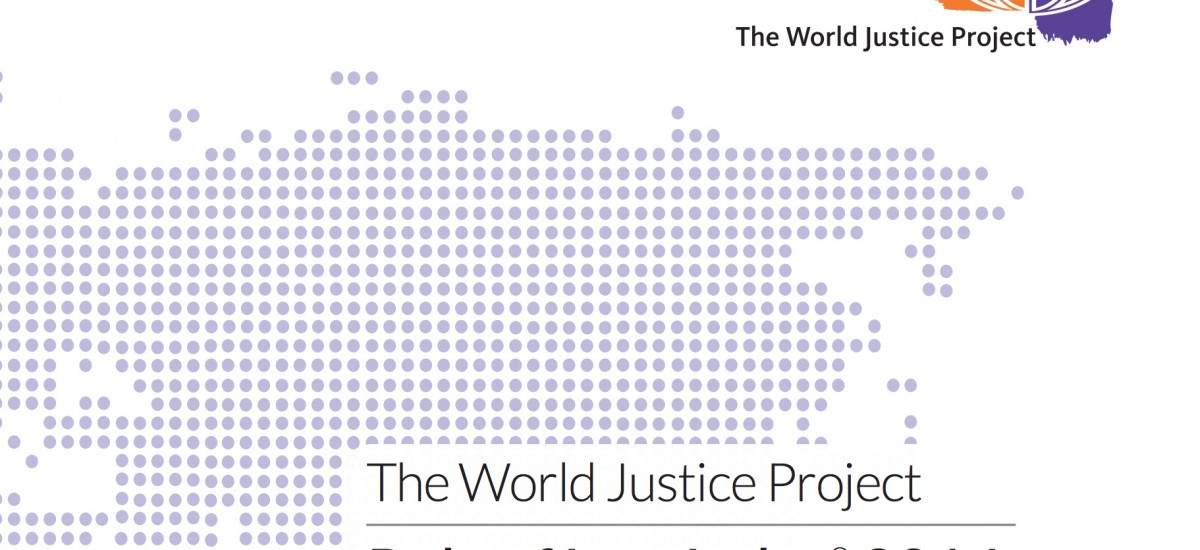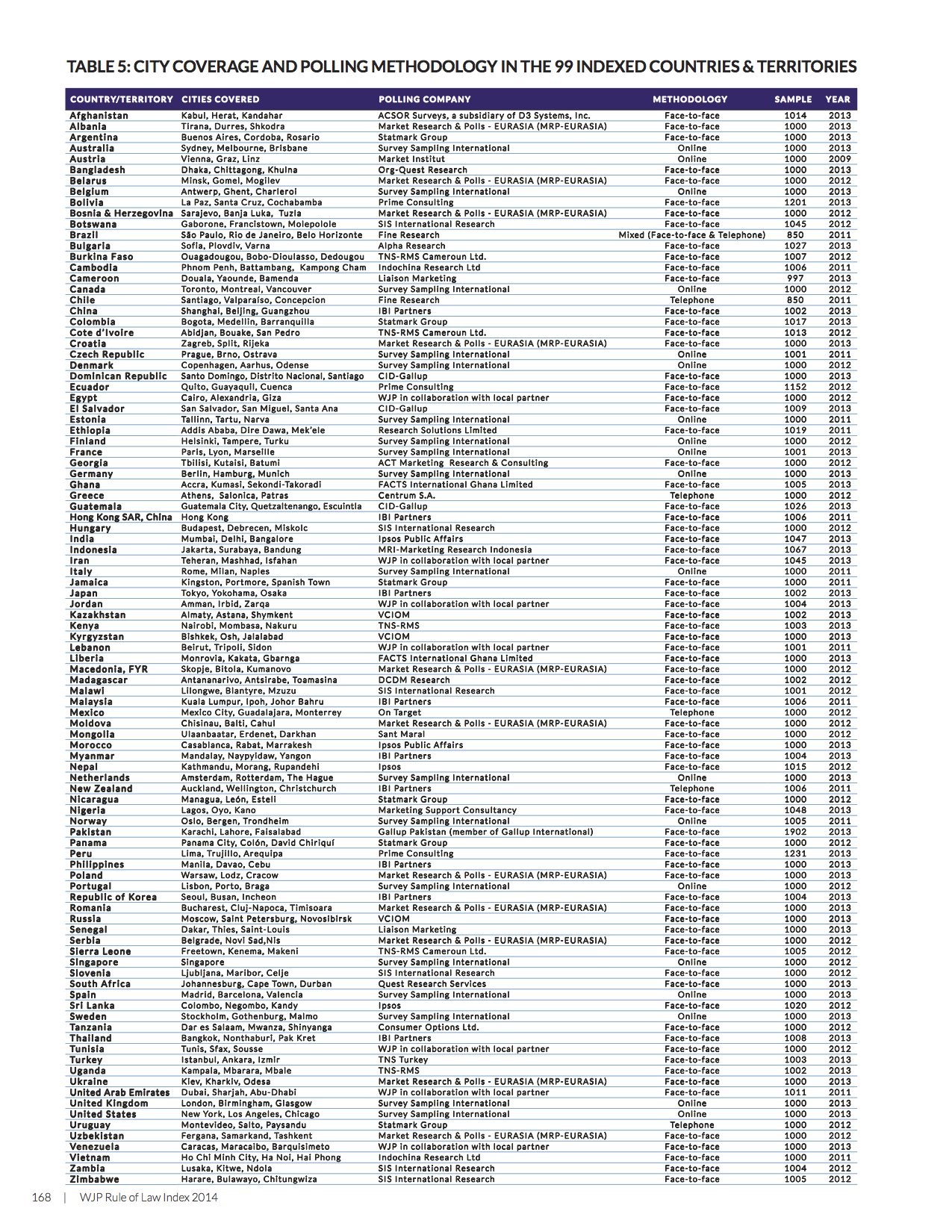How the World Justice Project’s Rule of Law Index 2014 was reported in Sri Lankan media reads as a cautionary tale when dealing with press releases.
The report was brought to my attention upon reading an ‘article’ in the Daily FT titled ‘World Justice Project’s Rule of Law Index 2014: Sri Lanka top in South Asia‘ (high resolution image here). The Daily FT is an award-winning newspaper, whose Editor-in-Chief is Nishthar Cassim, one of the country’s most senior and respected journalists. The ‘article’ noted that the Index ranked Sri Lanka “48th globally and outperforms its regional peers in most dimensions of the rule of law” and went on to note that “The World Justice Project has the support of outstanding leaders representing a range of disciplines around the world. Former US Secretary of State Madeleine Albright, former US President Jimmy Carter, former Ireland President Mary Robinson and South African social rights activist Bishop Desmond Tutu are among the Honorary Chairs of the World Justice Project”.
Titled ‘Sri Lanka ranked 48th in Rule of Law Index by the World Justice Project‘, News 1st, itself an award winning media outfit, also published an ‘article’ on the same report, on the same day (high resolution image here). In its reportage News 1st noted that, “The report takes into consideration 99 countries and jurisdictions and surveyed over 100,000 house holds and experts. According to the index, Sri Lanka ranks 48th globally and outperforms its regional peers in most dimensions of the rule of law”.
Confused as to how Sri Lanka could rank so high globally and out-rank other South Asian countries, I read through the methodology of the report.
Page 168 of the report, embedded above, makes this explicit. Sri Lanka’s ranking is based on data from 2012, taken only from face-to-face interviews conducted in Colombo, Negombo and Kandy. In short, the data was both woefully outdated and pegged to three metropolitan areas in the South of the country. Furthermore, listed in the report as a ‘Contributing Expert’ on Sri Lanka is Prathiba Mahanamahewa, the Dean of the Kotelawala Defence University (pg. 207), hardly someone expected to give a critical analysis around Sri Lanka’s culture of impunity. For just how outdated the underlying data of this report is, one only needs to recall the the impeachment of the Chief Justice in early 2013, seen as an unprecedented constitutional crisis.
And yet, neither Daily FT nor News 1st flag these points, easily discoverable in the report itself, in the framing or substance of their ‘articles’. One explanation came from the Deputy Editor of the Daily FT Marianne David, who claimed the ‘article’ was in fact a press release. I then flagged ethical concerns around a press release appearing on the Daily FT’s website as a news article.
@mariannedavid24 @ft_srilanka @tingilye This supposed PR is specifically noted under ‘News’ section of website #lka pic.twitter.com/w4ZPk5i5KR
— Groundviews (@groundviews) August 6, 2014
The Deputy Editor then claimed the original press release had been rewritten by the Editor-in-Chief of the Daily FT “in line with what he considered important”. Clearly then, Nishthar Cassim does not consider important that the data in the report from Sri Lanka isn’t national, isn’t current and doesn’t address, in any way, the impeachment of the country’s Chief Justice and resulting concerns over the Rule of Law, which are pressing and persist.
The full exchange over Twitter is in the public domain. As I noted,
@mariannedavid24 @tingilye @ft_srilanka So again, why did Editor miss out on *key* fact reg. report? Expect far better from paper / Editor.
— Groundviews (@groundviews) August 6, 2014
The concern at the time came from the hunch that government media and officials would use the report, and the manner in which it was presented in Daily FT and News 1st, for entirely partisan ends. Quickly confirming this, Charitha Herath, the social media savvy Secretary, Ministry of Mass Media and Information retweeted the News 1st tweet on their article. The Secretary’s response to being called out on retweeting what was a deeply flawed article revealed, and not for the first time, the larger mentality of a regime where facts are entirely peripheral, or created on-demand to suit their fiction.
@groundviews @newsfirst_en interesting. Seems u think that Good Journalism is only contributing to opposition agendas! @NalakaG
— Charitha Herath (@charith9) August 7, 2014
The government owned Daily News was unsurprisingly also quick to pick up on the report. Editorials on 9th and 11th August referenced the report in the usual spin that Sri Lanka’s democratic deficit is just a myth. By then, the damage was done. Whereas it is easy to immediately dismiss anything that is published or stated in the Daily News, the Daily FT and News 1st have very different, and indeed, far more highly regarded profiles. Propped up by both media institutions, the Sri Lanka’s ranking got a degree of credibility unattainable with just the use of State-owned media.
Interestingly, it was rumoured on Twitter that the press release on the report came from government sources. Though unconfirmed, language almost exactly mirroring the press release can be read on the website of the Sri Lankan High Commission in Washington DC, two days before it was published on the News 1st and Daily FT. Though very active on Twitter, the Daily FT and its Deputy Editor have not to date answered repeated questions on the source of the PR.
@MarianneDavid24 @tingilye Asking again reg. https://t.co/lCSOLarTkJ Can @FT_SriLanka say where flawed PR came from pl? Govt? #lka #srilanka
— Groundviews (@groundviews) August 9, 2014
What’s also unfortunate is that, the dubious ethics of publishing reworked press releases as news items aside, the report’s fundamental shortcomings flagged on Daily FT‘s website as comments haven’t been approved. Furthermore, despite a public exchange on Twitter over significant shortcomings of the report and related reportage with the Deputy Editor and the official handle of the Daily FT, no clarification or correction is present in the original article to date. The same goes for News 1st.
Good news about the Rajapaksa regime is rarely if ever that and it’s up to respected mainstream media and senior journalists to take apart, not fall victim to, sophisticated propaganda. A report which should have been dismissed as outdated and deeply flawed is instead, in the popular imagination, considered a serious marker of Sri Lanka’s rule of law. One risks disappointment to hope it will never happen again.


